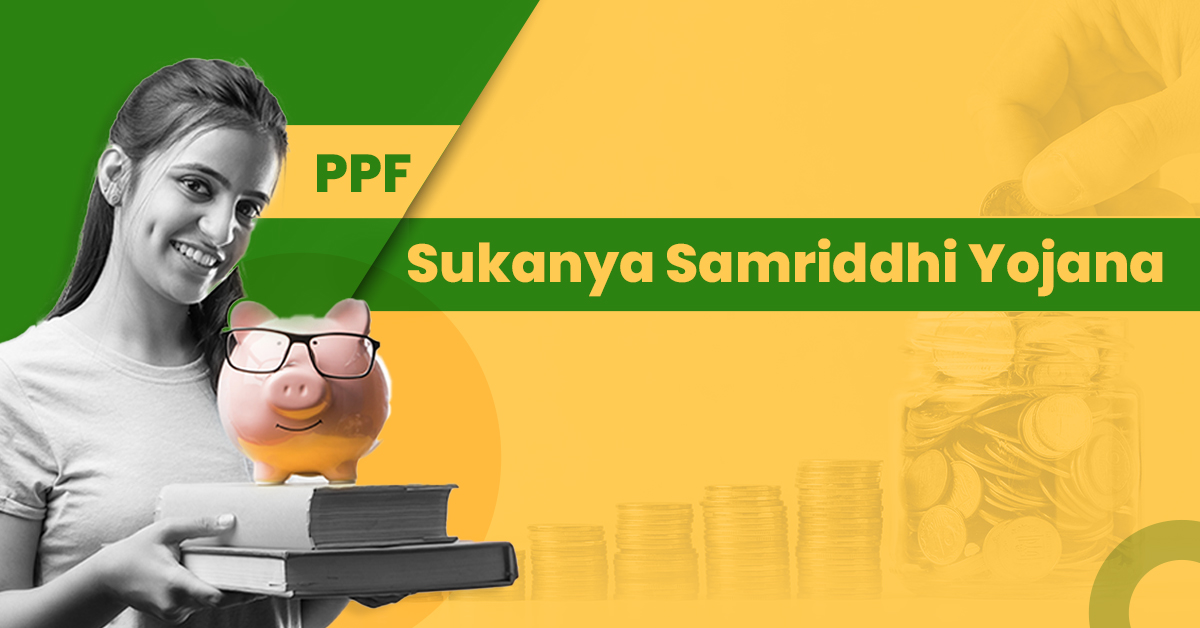Sukanya Samriddhi Yojana vs. PPF: All You Need to Know


The money market is flooded with investment options, making it challenging to choose the right one. Experts advise carefully comparing various factors, such as your financial goal, risk appetite, the interest rate offered by a specific investment scheme, the maturity period, and money market risks, before investing.
Many people choose the Sukanya Samriddhi Yojana (SSY) and Public Provident Funds (PPF) for their high-interest rates and low risk on returns. You can invest in the former only if you have a girl child. Nevertheless, before investing in any of these schemes, you must know what sets them apart or, at the least, how to invest in them to maximise your returns. Read on to learn more about these two schemes, their differences, and their features so that you can make a better investment decision.
What is Public Provident Fund?
The Public Provident Fund, commonly known as PPF, is a fixed return, long-term investment scheme introduced by the Finance Ministry in 1968 to promote savings among the masses.
In this scheme, the central government pays a fixed interest on the invested amount. Interest is calculated on the minimum balance in PPF account between 5th and the end of each month. Also, interest is calculated monthly and compounded yearly. In PPF, the government guarantees both the invested and maturity amount, so the chances of default are almost negligible.
Read More: Public Provident Fund or PPF: Meaning, Features, and Benefits
To open a PPF account, you must visit your nearest post office or any public or private sector bank. In order to open a PPF account online one must have a NetBanking / MobileBanking enabled on their respective bank account.
What is the Sukanya Samriddhi Yojana scheme?
The Sukanya Samriddhi Yojana (SSY), or the Girl Child Prosperity Scheme, is an investment scheme by the Indian government designed to benefit girls. It is a savings scheme launched under the ‘Beti-Bachao, Beti-Padhao‘ (Save Girl Child, Educate Girl Child) initiative.
Only one SSY account can be opened by the legal or natural guardian of a girl child at any time following her birth until she becomes ten years of age. The purpose of this scheme is to allow the guardians to save for the girl’s education and career.
You can open two accounts for each girl if there are two girls in the family. Opening a third SSY account is allowed only in exceptional cases, such as in cases when the firstborn is a triplet or in case of twins in the second birth. Please note that the third account will be opened upon furnishing the relevant documents to the bank.
An SSY can be easily opened at your nearest post office or authorised commercial bank. However, in case the parents of a child are not present at the time of opening the account, the legal guardian will need to submit the child’s birth certificate along with proof of identity and residence. .
PPF vs. Sukanya Samriddhi Yojana: Key Differences
Now that you have a brief idea about the two schemes, you can compare Sukanya Samriddhi Yojana vs. PPF, based on various factors:
1. Eligibility criteria
Any earning individual who is a resident of India and above 18 years of age can open a PPF account.
Parents can also open a PPF account on behalf of a minor. If the minor doesn’t have parents or is of unsound mind, their legal grandparents can open a PPF account on the child’s behalf.
In the case of the SSY account, you can open it at any time between the birth of the girl and before she is ten years old. In this case as well, the parents or the legal guardian of the girl can open the SSY account for the girl. Under the SSY program, a family can open a maximum of two SSY accounts. If the girls are twins or if the first birth results in three girl childrens, their guardian or parents will be able to open a third account on their behalf.
2. Rate of Interest
Another factor that will influence your choice between PPF and Sukanya Samriddhi Yojana is the interest rate. For PPF, the rate of interest is 7.1% for the fourth quarter of the financial year 2023-24. The interest is calculated on the lowest balance in the PPF account between the 5th and the last day of the month, so it is wise to deposit your investments in the PPF before the 5th of every month.
Learn more about: What is Sukanya Samriddhi Yojana Interest Rate?
The interest rate on an SSY is 8.2%, calculated on the account’s minimum balance between the close of the 5th and the last day of each month.
3. Tax Benefits
You should also consider the tax benefits of the Sukanya Samriddhi Yojana and PPF before choosing to invest in the schemes.. Thankfully, both PPF and SSY fall under the Exempt-Exempt-Exempt (EEE) tax category.
Learn more about: What are the Benefits of Public Provident Fund (PPF)?
It means the investments made under these schemes are subject to tax deductions under Section 80C of the Income Tax Act, 1961, and the interest collected and the maturity amount are also tax-free.
4. Deposit Limit
In a financial year, the minimum deposit amount for a PPF account is Rs. 500, and the maximum amount is Rs. 1,50,000. On the other hand, the minimum and maximum deposit limits for Sukanya Samriddhi Yojana are Rs. 250 and Rs. 1,50,000, respectively.
5. Premature Withdrawal
You should also consider the premature withdrawal rules while comparing the Sukanya Samriddhi Yojana vs. PPF. Though the maturity period of a PPF account is 15 years, you are allowed to make a premature withdrawal at the end of six financial years.
As we continue to draw the comparison between SSY vs. PPF, it’s essential to understand that the maturity period of the SSY account is 21 years after opening the account. You can prematurely withdraw 50% of the deposited amount only when the girl attains 18 years of age, and that too for higher education purposes and upon successfully furnishing the required documents.
6. Maturity Period
The Public Provident Fund has a maturity period of 15 years starting from the end of the financial year in which the account was issued. You can extend this maturity period by a maximum of 5 years. The Sukanya Samriddhi account matures after 21 years of opening the account.
7. Premature Termination
It is essential to consider the premature termination period while comparing Sukanya Samriddhi Yojana vs. PPF. PPF accounts can be closed prematurely after five financial years in exceptional cases, such as for treating a life-threatening ailment or for the education of the account holder.
Premature closure is possible in SSY only under humanitarian grounds, such as the untimely demise of the account holder or if it has become difficult for the parent/ guardian to carry forward the account due to medical exigencies and life threatening diseases.
8. Nomination
It is possible to nominate a nominee for your PPF account, but not for one opened on behalf of a minor. In the case of an SSY account, you cannot appoint a nominee as long as the girl child on whose behalf the account has been opened is alive. In the event of the girl’s death before the SSY account’s maturity, you will need to appoint a nominee .
9. Loan Facility
In the case of PPF, you can draw a loan of up to 25% of the sum available, possibly at the end of the second year. However, this option is open till the end of the sixth financial year.
Unfortunately, you cannot take a loan against the deposited sum under the Sukanya Samriddhi Yojana as per the current rules.
Final Thoughts
Sukanya Samriddhi Yojana is exclusively for girls upto the age of 10, whereas PPF is available to all residents of India above 18 years of age, irrespective of gender. Both schemes have a long maturity period. However, SSY is a less liquid investment as compared to PPF.
A PPF can be withdrawn prematurely, generally after six financial years from the starting date of the account. However, you cannot withdraw money deposited in SSY until the child reaches the age of 18 or under certain conditions. On the other hand, the interest rate is higher under the SSY scheme than under the PPF scheme.
Since these schemes have negligible default risk, you can divide your surplus amount and invest in both schemes, provided you have a girl child.
FAQs
Can I open both a Public Provident Fund account and a Sukanya Samriddhi account?
Yes, you can open both a PPF account and an SSY account. You can open a PPF account if you’re an Indian resident above the age of 18, but you can open an SSY account only for a girl child who is ten years of age or below.
Who should choose PPF?
An Indian resident who is above 18 years of age and is looking to invest in a long-term scheme that offers guaranteed returns should choose PPF.
What are the documents required to open an SSY account?
You need to furnish the following documents to open an SSY account:
–Sukanya Samriddhi Yojana account opening form
-The girl child’s birth certificate
-The parent/legal guardian’s identity and address proof
-Other documents requested by the post office or by the bank.
How many times can I deposit the money in a financial year?
In the case of PPF, only 12 instalments are allowed in a financial year. However, in the case of SSY, if you choose to make deposits in instalments, then the period of interval between two successive instalments can be anything, as per your capability. No fixed number of promises is required in one financial year.
For how many years are the contributions (deposits/SIPs) allowed?
In the case of a PPF account, the minimum tenure is 15 years, which can be extended for up to five years. Thus, you can contribute to a PPF account for a minimum time of 15 years and a maximum of 20 years. On the other hand, you can make deposits for 15 years from the date of opening the SSY account.



